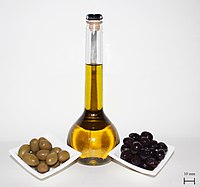
Photo from wikipedia
The main objective of this paper is to obtain extra virgin olive oils (EVOOs) which are balanced in volatile and phenolic compounds. An experimental design was performed and response surface… Click to show full abstract
The main objective of this paper is to obtain extra virgin olive oils (EVOOs) which are balanced in volatile and phenolic compounds. An experimental design was performed and response surface methodology was applied. The factors for malaxation were: temperature 20-40 °C, time 30-90 min, and hole diameter of hammer-crusher 4.5-6.5 mm. The results show that high temperatures and small hole diameter must be used in order to obtain a higher content in phenolic compounds, while for volatile compounds a low temperature and large hole diameter must be used. The models predict that the best and more balanced EVOO are obtained with the hole diameter of greater size and a medium-low temperature. Thus, for a hammer-crusher hole diameter of 6.5 mm 337 and 356 mg/kg total HPLC phenols were obtained for malaxation temperature of 20 and 25 °C, respectively and, likewise, 12.7 and 11.5 mg/kg total LOX volatiles.
Journal Title: Grasas Y Aceites
Year Published: 2018
Link to full text (if available)
Share on Social Media: Sign Up to like & get
recommendations!